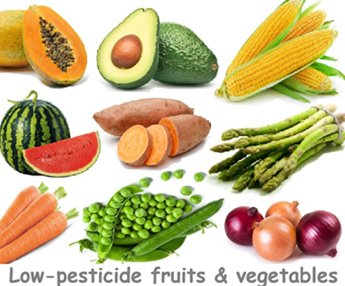The Clean Fifteen: Fruits and Vegetables with the Lowest Pesticide Levels
The Environmental Working Group (EWG) makes two lists each year. The “Dirty Dozen” shows foods with the most pesticides. The “Clean Fifteen” shows foods with the least.
This list highlights fruits and vegetables that typically contain the lowest levels of pesticide residues, making them a safer choice for those looking to reduce their chemical exposure without always buying organic.
The list is based on testing data from the U.S. Department of Agriculture and the Food and Drug Administration. These foods often need fewer pesticides because they have thick skins, grow in pest-resistant conditions, or are less attractive to insects.
As a result, they retain fewer chemical residues after harvest, washing, and preparation.

Topping the “Clean Fifteen” list are:
✅ Avocados – ~65–70% have no pesticides,
✅ Sweet corn – very low pesticide levels,
✅ Pineapples – thick skin protects,
✅ Onions – natural pest repellent, and
✅ Papayas – often pest-resistant
Other low-pesticide foods include:
✅ Frozen sweet peas, asparagus, honeydew melons, kiwifruit, and cabbage, all of which typically require minimal pesticide applications during growth.
✅ Mushrooms and mangoes also appear regularly on the list, along with watermelon, sweet potatoes, and carrots, which tend to be less affected by pests or have protective outer skins.
Buying foods from the “Clean Fifteen” can help you eat healthy and save money. You can often buy them in regular (non-organic) form without much worry about pesticide residues.
It is still important to wash all produce well. This removes dirt, bacteria, and any small traces of chemicals. Peeling foods like carrots or mangoes can also help.
The “Clean Fifteen” is a good guide for shoppers. By choosing conventional versions of these, consumers can reduce pesticide exposure significantly without overspending.
Bottom line:
The “Clean Fifteen” serves as a reminder that fresh produce remains a cornerstone of a healthy diet. The benefits of eating a variety of fruits and vegetables—whether organic or conventional—far outweigh the risks, especially when consumers are informed and strategic in their choices.
By prioritizing low-pesticide or organic produce, consumers can reduce their exposure to potentially harmful chemicals without sacrificing the nutritional benefits of fruits and vegetables.
In this regard, the EWG’s report is a reminder that transparency in our food system matters. With clear and accessible information, people can make informed choices to protect their health while still enjoying the variety and nutrition fresh produce provides.
Medical Disclaimer.
Read further on:
≺≺ What are antioxidants? How antioxidants in the fruits and vegetables help in preventing cancers and diseases?
≺≺ What foods should people with high blood pressure avoid?
≺≺ How can I reduce the risk of cancer-causing chemicals when cooking or grilling meat?
≺≺ How toxic are the nitrites used in curing processed meats?
≺≺ What are the worst meats for accumulating cancer-causing chemicals during cooking?
≺≺ How are artificial sweeteners made?
≺≺ Can Physical Activity Help Improve My Arthritis?
≺≺ How common is thumb pain from too much texting?
≺≺ What health problems are linked to consuming corn syrup?
≺≺ What happens to my blood vessels when I gain weight?
≺≺ What are the four enemies of blood sugar?
≺≺ What type of exercise is best for lowering my blood sugar?
≺≺ What impact can sitting for long periods have on my health?
≺≺ Does my social circle impact my weight?
≺≺ How toxic are the nitrites used in curing processed meats?
≺≺ How can I reduce the risk of cancer-causing chemicals when cooking or grilling meat?
≺≺ What foods can lower prostate cancer risk?
≻≻ Watch this page for more such informative articles on Health, Nutrition, and Wellness.
≻≻-Back to Home page.
Further reading (External Links opens in new window):
≺≺- -By EWG Science Team- EWG’s 2025 Shopper’s Guide to Pesticides in Produce.

